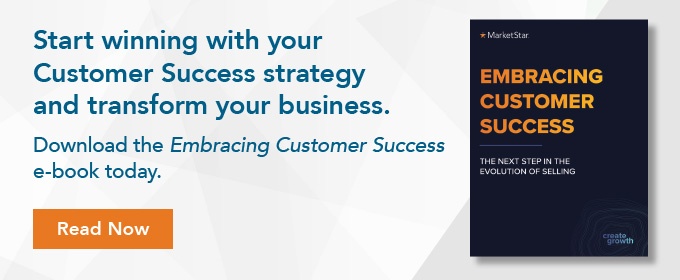.jpg?width=1160&name=MarketStar%20Blog%20%23150%20%20(1).jpg)
The overall success of any sales and marketing initiative ultimately hinges on customer success. It’s one thing to complete a sale or close a contract, but the ultimate goal is to ensure that the customer receives maximum value from the sale or engagement. Turning a sale into a successful engagement means happy customers, which translates into additional sales to those customers and reduced customer churn.
The challenge for many organizations is integrating customer success into the sales and marketing process. Customer success needs to be a seamless and logical part of the customer experience, so the customer feels supported from the initial sales contact through to post-sale onboarding and support.
Why You Need Customer Success
Customer success is a business methodology that ensures your customers achieve their desired outcome by using your products or services. That’s the definition—but let’s consider customer success another way.
Think about what it takes to succeed in a new job. Someone needs to train you and show you how to succeed in that role. Customer success is similar. It provides customers with the skills and abilities to succeed in using a product or service to achieve desired results. Customer success experts serve as trainers to help customers become proficient and excel at whatever they are trying to accomplish. It pays for every organization to invest in customer success.
Why do you need a customer success organization or team? We have seven reasons that we share with our clients:
1. It prevents customer churn.
Research shows that customer retention costs one-fifth the expense of customer acquisition. By reducing churn, you are promoting business growth.
2. It promotes customer growth.
The success rate of selling to customers you already have is 60-70 percent higher than selling new customers. Demonstrating customer success increases engagement.
3. It helps you develop better products for more customers to adopt.
You learn from customer success. Showing customers how to get more from your products and services reveals weaknesses in the product as well as new opportunities.
4. It increases customer satisfaction.
Happy customers return to buy more. You get more revenue from current customers. A 5% retention rate can increase profits 25%. To achieve maximum customer lifetime value (LTV) you want customers to keep coming back to buy more and buy more frequently.
5. It gives you the ability to manage the end-to-end customer journey.
Having control of the customer journey post-sale allows you to overcome obstacles and improve customer satisfaction.
6. It drives customer adoption.
Driving adoption is important, especially in technology selling. Too often, customers buy products that become shelfware that remains unused and therefore provides no value.
7. It is a proactive approach to building sustainable customer relationships.
The deeper the customer engagement, the greater the opportunity to upsell and cross-sell, and keep customers.
Making Customer Success Work for You
To make customer success work for your organization requires laying some groundwork in advance:
You want to be clear about your desired outcomes. Before you can deliver on customer success, you need to be sure your idea of success aligns with the customer’s. Define the nature of the working relationship and what they want to accomplish. Also, build customer engagement into the plan. Have regular check-ins and progress reviews, and be sure to assemble the data needed to analyze results.
Each customer segment is different and has different needs, so you need a mix of technology and people assets to meet those varying needs. Identify the resources you will need to satisfy all the stakeholders in the sale as part of customer success.
Be sure to list the milestones on the way to reaching the ultimate goal. Create a list of accomplishments that your customer success experts need to achieve with the customer to ensure success. Also, be clear about the success gap you’ll have to bridge along the way and the problems you will have to overcome.
What is Customer Success and why is it important? Check out our video.
Creating a Customer Success Plan
To effectively manage customer success, you need a plan. The plan needs to be a series of time-data-event-based actions that reflect customer success at every stage of the customer lifecycle.
Demonstrating customer success also requires having the right data at hand. When you agree on desired outcomes, you should also agree on metrics for success. How will you measure customer success? Does success look like shortening processing time, increasing accuracy, cutting costs, or gaining some other benefit? Whatever the metric, your success plan needs to include reporting mechanisms to prove success, including the data sources needed to populate the reports.
Don’t underestimate the power of customer success. More organizations are investing in improving customer experience, and ensuring customer success provides the ultimate customer experience. Creating a culture built on customer success not only helps build recurring revenue from satisfied customers, but it also can educate you about the strengths and weaknesses of your offering, so you gain a deeper understanding of what customers want and why they buy in the first place. An effective customer success program gives you a competitive edge that is hard to beat.
If you want to learn more about customer success, be sure to read our e-book, Embracing Customer Success.







